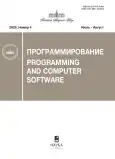Do internal software metrics have relationship with fault-proneness and change-proneness?
- Authors: Rahman M.M.1, Ahammed T.1, Joarder M.M.1, Sakib K.1
-
Affiliations:
- Institute of Information Technology (IIT), University of Dhaka (DU)
- Issue: No 4 (2025)
- Pages: 71-82
- Section: SOFTWARE ENGINEERING, TESTING AND VERIFICATION OF PROGRAMS
- URL: https://journal-vniispk.ru/0132-3474/article/view/349254
- DOI: https://doi.org/10.7868/S3034584725040063
- ID: 349254
Cite item
Abstract
About the authors
M. M. Rahman
Institute of Information Technology (IIT), University of Dhaka (DU)
Email: bit0413@iit.du.ac.bd
Dhaka, Bangladesh
T. Ahammed
Institute of Information Technology (IIT), University of Dhaka (DU)
Email: toukir@iit.du.ac.bd
Dhaka, Bangladesh
M. M. A. Joarder
Institute of Information Technology (IIT), University of Dhaka (DU)
Email: joarder@iit.du.ac.bd
Dhaka, Bangladesh
K. Sakib
Institute of Information Technology (IIT), University of Dhaka (DU)
Email: sakib@iit.du.ac.bd
Dhaka, Bangladesh
References
- ISO IEC 9126-1: Software Engineering-Product Quality – Part 1: Quality Model, Geneva: International Organization for Standardization, 2001.
- Alshayeb M. Empirical investigation of refactoring effect on software quality. Inf. Software Technol. 2009. V. 51. № 9. P. 1319–1326. https://doi.org / 10.1016 / j.infsof.2009.04.002
- Zhang F., Mockus A., Zou Yi., Khomh F., Hassan A.E. How does context affect the distribution of software maintainability metrics. International Conference on Software Maintenance (ICSM). 2013. P. 350–359. https://doi.org / 10.1109 / ICSM.2013.4
- Palomba F., Bavota G., Di Penta M., Fasano F., Oliveto R., De Lucia A. On the diffuseness and the impact on maintainability of code smells: A large scale empirical investigation. Empirical Software Eng. 2018. V. 23. № 3. P. 1188–1221. https://doi.org / 10.1007 / s10664-017-9535-z
- Zhou Yu., Leung H., Xu B. Examining the potentially confounding effect of class size on the associations between object-oriented metrics and changeproneness. IEEE Trans. Software Eng. 2009. V. 35. № 5. P. 607–623. https://doi.org / 10.1109 / TSE.2009.32
- Shatnawi R., Li W. The effectiveness of software metrics in identifying error-prone classes in post-release software evolution process. J. Syst. Software. 2008. V. 81. № 11. P. 1868–1882. https://doi.org / 10.1016 / j.jss.2007.12.794
- Lu H., Zhou Yu., Xu B., Leung H., Chen L. The ability of object-oriented metrics to predict change-proneness: A meta-analysis. Empirical Software Eng. 2012. V. 17. № 3. P. 200–242. https://doi.org / 10.1007 / s10664-011-9170-z
- Radjenović D., Heričko M., Torkar R., Živkovič A. Software fault prediction metrics: A systematic literature review. Inf. Software Technol. 2013. V. 55. № 8. P. 1397–1418. https://doi.org / 10.1016 / j.infsof.2013.02.009
- Rahman F. Devanbu P. How, and why, process metrics are better. 35th International Conference on Software Engineering (ICSE). San Francisco, 2013. IEEE. 2013. P. 432–441. https://doi.org / 10.1109 / ICSE.2013.6606589
- Malhotra R., Khanna M. Investigation of relationship between object-oriented metrics and change proneness. Int. J. Mach. Learn. Cybern. 2013. V. 4. № 4. P. 273–286. https://doi.org / 10.1007 / s13042-012-0095-7
- Olague H.M., Etzkorn L.H., Gholston S., Quattlebaum S. Empirical validation of three software metrics suites to predict fault- proneness of object-oriented classes developed using highly iterative or agile software development processes. IEEE Trans. Software Eng. 2007. V. 33. № 6. P. 402–419. https://doi.org / 10.1109 / TSE.2007.1015
- Eski S., Buzluca F. An empirical study on objectoriented metrics and software evolution in order to reduce testing costs by predicting change-prone classes. 2011 IEEE Fourth International Conference on Software Testing, Verification and Validation Workshops, Berlin, 2011. IEEE. 2011. P. 566–571. https://doi.org / 10.1109 / icstw.2011.43
- Khomh F., Di Penta M., Gueheneuc Y.-G. An exploratory study of the impact of code smells on software change-proneness, 2009 16th Working Conference on Reverse Engineering, Lille, France, 2009. IEEE. 2009. P. 75–84. https://doi.org / 10.1109 / wcre.2009.28
- Rahman Md.M., Ahammed T., Joarder Md.M.A., Sakib K. Does code smell frequency have a relationship with fault-proneness. Proceedings of the 27th International Conference on Evaluation and Assessment in Software Engineering, Oulu, Finland, 2023, New York: Association for Computing Machinery. 2023. P. 261–262. https://doi.org / 10.1145 / 3593434.3593457
- Aggarwal K.K., Singh Yo., Kaur A., Malhotra R. Empirical analysis for investigating the effect of object-oriented metrics on fault proneness: A replicated case study. Software Process: Improvement and Practice. 2009. V. 14. № 1. P. 39–62. https://doi.org / 10.1002 / spip.389
- Pecorelli F., Palomba F., Khomh F., De Lucia A. Developer-driven code smell prioritization. Proceedings of the 17th International Conference on Mining Software Repositories, Seoul, 2020, New York: Association for Computing Machinery. 2020. P. 220–231. https://doi.org / 10.1145 / 3379597.3387457
- Gupta S.C., Kapoor V.K. Fundamentals of Mathematical Statistics. Sultan Chand & Sons, 2020.
- Cohen J. Statistical Power Analysis for the Behavioral Sciences. New York: Routledge, 2013, 2nd ed. https://doi.org / 10.4324 / 9780203771587
Supplementary files









